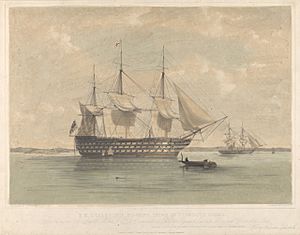HMS Caledonia (1808) facts for kids

HMS Caledonia, 120 guns, lying in Plymouth Sound
|
|
Quick facts for kids History |
|
|---|---|
| Name | HMS Caledonia |
| Ordered | 19 January 1797 |
| Builder | Plymouth Dockyard |
| Laid down | January 1805 |
| Launched | 25 June 1808 |
| Renamed | HMS Dreadnought, 1856 |
| Honours and awards |
Participated in bombardment of Algiers, 1816 |
| Fate | Broken up, 1875 |
| General characteristics | |
| Class and type | Caledonia-class ship of the line |
| Tons burthen | 26165⁄94 (bm) |
| Length | 205 ft (62 m) (gundeck) |
| Beam | 53 ft 6 in (16.31 m) |
| Depth of hold | 23 ft 2 in (7.06 m) |
| Propulsion | Sails |
| Sail plan | Full-rigged ship |
| Armament |
|
HMS Caledonia was a huge warship of the Royal Navy, launched on June 25, 1808. It was a "first-rate ship of the line," which means it was one of the largest and most powerful warships of its time. It had 120 guns! Caledonia served as the main ship, or "flagship," for Admiral Pellew in the Mediterranean Sea.
Contents
Building a Giant Ship
The British Admiralty (the government department in charge of the navy) first ordered Caledonia to be built in 1794. It was planned to be a 100-gun ship. However, there were many delays in getting the right building space and enough workers.
Building finally started in 1805 at Plymouth Dockyard. By then, the plans had changed. Caledonia was now designed to be even bigger, with 120 guns. When it was finished in 1808, it was the largest and most heavily armed ship in the Royal Navy.
Life at Sea
Caledonia was known as a very successful ship. Sailors said it was easy to handle and sailed very well. It was considered "faultless" by everyone who sailed on it. Because it was so well-designed, Caledonia became the model for other large British warships built later.
On February 12, 1814, Caledonia teamed up with another British ship, HMS Boyne. They faced a French warship called Romulus near Toulon, France. The French ship managed to escape by sailing very close to the coast, where the bigger British ships couldn't easily follow.
Testing New Ideas
In 1831, Caledonia was part of a special group of ships called the Experimental Squadron. This group tested new ideas for the Channel Fleet. On September 12, 1831, Caledonia took part in an unusual experiment. It was towed by a smaller ship, HMS Galatea, using only hand-powered paddles!
Later Years and Legacy
In 1856, Caledonia was changed into a hospital ship. It was renamed Dreadnought and became the second floating hospital for sailors, known as the Dreadnought Seamen's Hospital, located in Greenwich. It stayed there until 1870.
In 1871, it was briefly used again as a "lazaret." A lazaret is a place to keep people who are recovering from serious illnesses, like the smallpox epidemic that year. Caledonia was finally taken apart for scrap in 1875.
Images for kids
-
A painting showing the fight between the Romulus and British ships HMS Boyne and HMS Caledonia.



